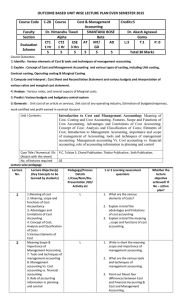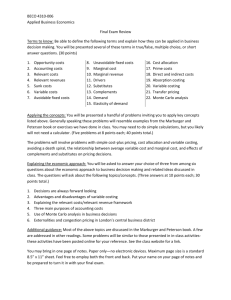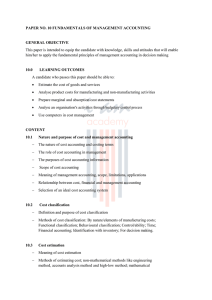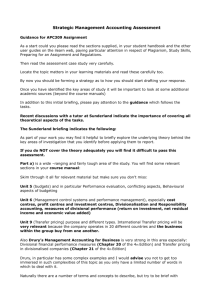Marginal and absorption costing
advertisement
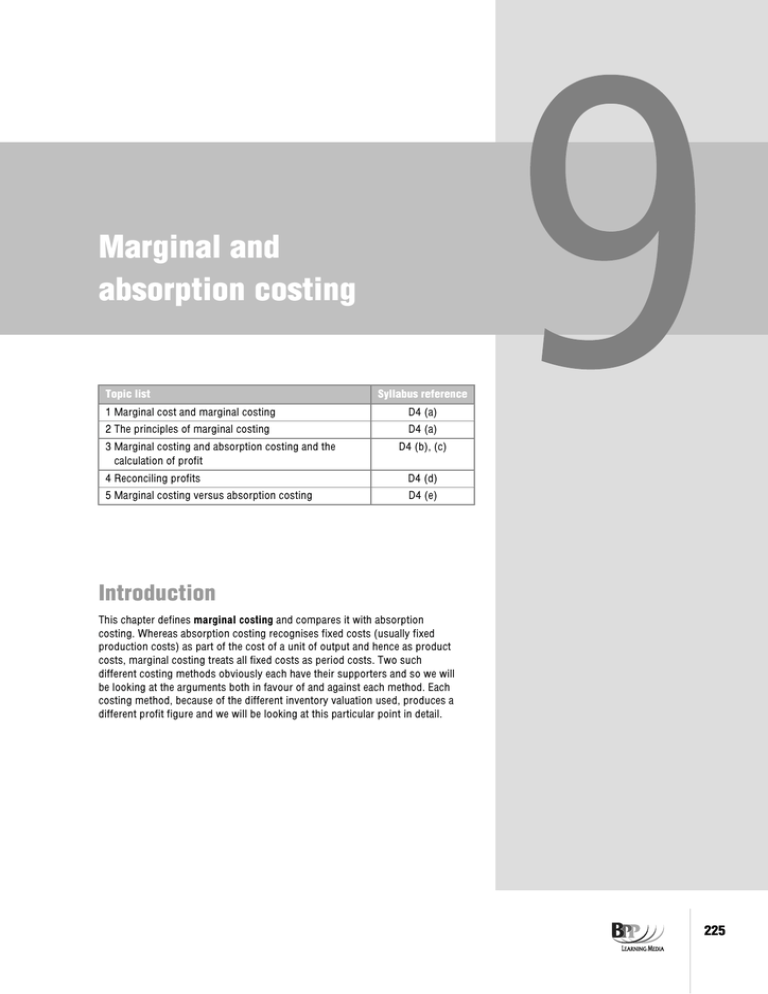
Marginal and absorption costing Topic list Syllabus reference 1 Marginal cost and marginal costing D4 (a) 2 The principles of marginal costing D4 (a) 3 Marginal costing and absorption costing and the calculation of profit D4 (b), (c) 4 Reconciling profits D4 (d) 5 Marginal costing versus absorption costing D4 (e) Introduction This chapter defines marginal costing and compares it with absorption costing. Whereas absorption costing recognises fixed costs (usually fixed production costs) as part of the cost of a unit of output and hence as product costs, marginal costing treats all fixed costs as period costs. Two such different costing methods obviously each have their supporters and so we will be looking at the arguments both in favour of and against each method. Each costing method, because of the different inventory valuation used, produces a different profit figure and we will be looking at this particular point in detail. 225 PART D COST ACCOUNTING TECHNIQUES Study guide Intellectual level D4 Marginal and absorption costing (a) Explain the importance and apply the concept of contribution 1 (b) 2 (c) Demonstrate and discuss the effect of absorption and marginal costing on inventory valuation and profit determination Calculate profit or loss under absorption and marginal costing (d) Reconcile the profits or losses calculated under absorption and marginal costing 2 (e) Describe the advantages and disadvantages of absorption and marginal costing 1 2 Exam guide Look out for questions in your examination which require you to calculate profit or losses using absorption and marginal costing. 1 Marginal cost and marginal costing 1.1 Introduction FAST FORWARD Key term Marginal cost is the variable cost of one unit of product or service. Marginal costing is an alternative method of costing to absorption costing. In marginal costing, only variable costs are charged as a cost of sale and a contribution is calculated (sales revenue minus variable cost of sales). Closing inventories of work in progress or finished goods are valued at marginal (variable) production cost. Fixed costs are treated as a period cost, and are charged in full to the profit and loss account of the accounting period in which they are incurred. The marginal production cost per unit of an item usually consists of the following. • • • Direct materials Direct labour Variable production overheads Direct labour costs might be excluded from marginal costs when the work force is a given number of employees on a fixed wage or salary. Even so, it is not uncommon for direct labour to be treated as a variable cost, even when employees are paid a basic wage for a fixed working week. If in doubt, you should treat direct labour as a variable cost unless given clear indications to the contrary. Direct labour is often a step cost, with sufficiently short steps to make labour costs act in a variable fashion. The marginal cost of sales usually consists of the marginal cost of production adjusted for inventory movements plus the variable selling costs, which would include items such as sales commission, and possibly some variable distribution costs. 1.2 Contribution FAST FORWARD Contribution is an important measure in marginal costing, and it is calculated as the difference between sales value and marginal or variable cost of sales. Contribution is of fundamental importance in marginal costing, and the term 'contribution' is really short for 'contribution towards covering fixed overheads and making a profit'. 226 9: MARGINAL AND ABSORPTION COSTING 2 The principles of marginal costing The principles of marginal costing are as follows. (a) Period fixed costs are the same, for any volume of sales and production (provided that the level of activity is within the 'relevant range'). Therefore, by selling an extra item of product or service the following will happen. • • • Revenue will increase by the sales value of the item sold. Costs will increase by the variable cost per unit. Profit will increase by the amount of contribution earned from the extra item. (b) Similarly, if the volume of sales falls by one item, the profit will fall by the amount of contribution earned from the item. (c) Profit measurement should therefore be based on an analysis of total contribution. Since fixed costs relate to a period of time, and do not change with increases or decreases in sales volume, it is misleading to charge units of sale with a share of fixed costs. Absorption costing is therefore misleading, and it is more appropriate to deduct fixed costs from total contribution for the period to derive a profit figure. (d) When a unit of product is made, the extra costs incurred in its manufacture are the variable production costs. Fixed costs are unaffected, and no extra fixed costs are incurred when output is increased. It is therefore argued that the valuation of closing inventories should be at variable production cost (direct materials, direct labour, direct expenses (if any) and variable production overhead) because these are the only costs properly attributable to the product. 2.1 Example: Marginal costing principles Rain Until September Co makes a product, the Splash, which has a variable production cost of $6 per unit and a sales price of $10 per unit. At the beginning of September 20X0, there were no opening inventories and production during the month was 20,000 units. Fixed costs for the month were $45,000 (production, administration, sales and distribution). There were no variable marketing costs. Required Calculate the contribution and profit for September 20X0, using marginal costing principles, if sales were as follows. (a) (b) (c) 10,000 Splashes 15,000 Splashes 20,000 Splashes Solution The stages in the profit calculation are as follows. • • • To identify the variable cost of sales, and then the contribution. Deduct fixed costs from the total contribution to derive the profit. Value all closing inventories at marginal production cost ($6 per unit). 227 PART D COST ACCOUNTING TECHNIQUES Sales (at $10) Opening inventory Variable production cost Less value of closing inventory (at marginal cost) Variable cost of sales Contribution Less fixed costs Profit/(loss) 10,000 Splashes $ $ 100,000 0 120,000 15,000 Splashes $ $ 150,000 0 120,000 120,000 120,000 60,000 Profit (loss) per unit Contribution per unit 20,000 Splashes $ $ 200,000 0 120,000 120,000 30,000 – 60,000 40,000 45,000 (5,000) 90,000 60,000 45,000 15,000 120,000 80,000 45,000 35,000 $(0.50) $4 $1 $4 $1.75 $4 The conclusions which may be drawn from this example are as follows. (a) The profit per unit varies at differing levels of sales, because the average fixed overhead cost per unit changes with the volume of output and sales. (b) The contribution per unit is constant at all levels of output and sales. Total contribution, which is the contribution per unit multiplied by the number of units sold, increases in direct proportion to the volume of sales. (c) Since the contribution per unit does not change, the most effective way of calculating the expected profit at any level of output and sales would be as follows. • • (d) First calculate the total contribution. Then deduct fixed costs as a period charge in order to find the profit. In our example the expected profit from the sale of 17,000 Splashes would be as follows. $ 68,000 45,000 23,000 Total contribution (17,000 × $4) Less fixed costs Profit • • • If total contribution exceeds fixed costs, a profit is made If total contribution exactly equals fixed costs, no profit or loss is made If total contribution is less than fixed costs, there will be a loss Question Marginal costing principles Mill Stream makes two products, the Mill and the Stream. Information relating to each of these products for April 20X1 is as follows. Mill Stream Opening inventory nil nil Production (units) 15,000 6,000 Sales (units) 10,000 5,000 Sales price per unit Unit costs Direct materials Direct labour Variable production overhead Variable sales overhead 228 $$20 $ 8 4 2 2 $30 $ 14 2 1 3 9: MARGINAL AND ABSORPTION COSTING Fixed costs for the month Production costs Administration costs Sales and distribution costs $ 40,000 15,000 25,000 Required (a) (b) Using marginal costing principles and the method in 2.1(d) above, calculate the profit in April 20X1. Calculate the profit if sales had been 15,000 units of Mill and 6,000 units of Stream. Answer $ 40,000 50,000 90,000 80,000 10,000 (a) Contribution from Mills (unit contribution = $20 – $16 = $4 × 10,000) Contribution from Streams (unit contribution = $30 – $20 = $10 × 5,000) Total contribution Fixed costs for the period Profit (b) At a higher volume of sales, profit would be as follows. Contribution from sales of 15,000 Mills (× $4) Contribution from sales of 6,000 Streams (× $10) Total contribution Less fixed costs Profit $ 60,000 60,000 120,000 80,000 40,000 2.2 Profit or contribution information The main advantage of contribution information (rather than profit information) is that it allows an easy calculation of profit if sales increase or decrease from a certain level. By comparing total contribution with fixed overheads, it is possible to determine whether profits or losses will be made at certain sales levels. Profit information, on the other hand, does not lend itself to easy manipulation but note how easy it was to calculate profits using contribution information in the question entitled Marginal costing principles. Contribution information is more useful for decision making than profit information, as we shall see when we go on to study decision making in Section F of this Study Text. 3 Marginal costing and absorption costing and the calculation of profit 3.1 Introduction FAST FORWARD In marginal costing, fixed production costs are treated as period costs and are written off as they are incurred. In absorption costing, fixed production costs are absorbed into the cost of units and are carried forward in inventory to be charged against sales for the next period. Inventory values using absorption costing are therefore greater than those calculated using marginal costing. Marginal costing as a cost accounting system is significantly different from absorption costing. It is an alternative method of accounting for costs and profit, which rejects the principles of absorbing fixed overheads into unit costs. 229 PART D COST ACCOUNTING TECHNIQUES Marginal costing Absorption costing Closing inventories are valued at marginal production cost. Closing inventories are valued at full production cost. Fixed costs are period costs. Fixed costs are absorbed into unit costs. Cost of sales does not include a share of fixed overheads. Cost of sales does include a share of fixed overheads (see note below). Note. The share of fixed overheads included in cost of sales are from the previous period (in opening inventory values). Some of the fixed overheads from the current period will be excluded by being carried forward in closing inventory values. In marginal costing, it is necessary to identify the following. • • • Variable costs Contribution Fixed costs In absorption costing (sometimes known as full costing), it is not necessary to distinguish variable costs from fixed costs. 3.2 Example: Marginal and absorption costing compared Look back at the information contained in the question entitled: Marginal costing principles. Suppose that the budgeted production for April 20X1 was 15,000 units of Mill and 6,000 units of Stream, and production overhead is absorbed on the basis of budgeted direct labour costs. Required Calculate the profit if production was as budgeted, and sales were as follows. (a) (b) 10,000 units of Mill and 5,000 units of Stream 15,000 units of Mill and 6,000 units of Stream Administration, sales and distribution costs should be charged as a period cost. Solution Budgeted production overhead is calculated as follows. Fixed Variable: Mills (15,000 × $2) Streams (6,000 × $1) Total The production overhead absorption rate would be calculated as follows. Budgeted production overhead Budgeted direct labour cost = $76,000 × 100% (15,000 × $4) + (6,000 × $2) = 105.56% of direct labour cost 230 $ 40,000 30,000 6,000 76,000 9: MARGINAL AND ABSORPTION COSTING (a) If sales are 10,000 units of Mill and 5,000 units of Stream, profit would be as follows. Costs of production Direct materials Direct labour Overhead (105.56% of labour) Less closing stocks (W1) Production cost of sales Administration costs Sales and distribution costs Variable (W2) Fixed Total cost of sales Sales Profit Absorption costing Mills Streams $ $ 120,000 60,000 63,333 243,333 81,111 162,222 200,000 84,000 12,000 12,667 108,667 18,111 90,556 150,000 Total $ 204,000 72,000 76,000 352,000 99,222 252,778 15,000 35,000 25,000 327,778 350,000 22,222 Note. There is no under-/over-absorption of overhead, since actual production is the same as budgeted production. The profit derived using absorption costing techniques is different from the profit ($10,000) using marginal costing techniques at this volume of sales (see earlier question). (b) If production and sales are exactly the same, (15,000 units of Mill and 6,000 units of Stream) profit would be $40,000. $ Sales (300,000 + 180,000) 480,000 Cost of sales (W3) 440,000 Profit 40,000 * No closing inventory if sales and production are equal. Workings 1 Closing inventories (a) If 15,000 units of Mills are produced and only 10,000 units are sold, there will be closing inventories of 5,000 units (15,000 – 10,000). Therefore, of the production costs of $243,333, 5,000 units of the 15,000 units produced (5,000/15,000 = 1/3) will be carried forward in closing inventory ie 1/3 × $243,333 = $81,111. (b) Similarly, if 6,000 units of Streams are produced and only 5,000 units are sold there will be closing inventories of 1,000 units (6,000– 5,000). Therefore, of the production cost of $108,667, 1,000 units of the 6,000 units produced (1,000/6,000 = 1/6) will be carried forward in closing inventory ie 1/6 × $108,667 = $8,111. 2 Variable sales and distribution costs Mills Variable sales and distribution costs = $2 (from Question entitled 'marginal costing principles') × 10,000 units = $20,000 Streams Variable sales and distribution costs = $3 (from Question entitled 'marginal costing principles') × 5,000 units 231 PART D COST ACCOUNTING TECHNIQUES = $15,000 ∴Total sales and distribution costs 3 = $20,000 + $15,000 = $35,000 Cost of sales $ Costs of production (from part (a)) Administration costs (from Question entitled 'marginal costing principles') Fixed sales and distribution costs (from Question entitled 'marginal costing principles') Variable sales overhead Mills (15,000 × $2) Streams (6,000 × $3) $ 352,000 15,000 25,000 30,000 18,000 48,000 440,000 This is the same as the profit calculated by marginal costing techniques in the earlier question. We can draw a number of conclusions from this example. (a) Marginal costing and absorption costing are different techniques for assessing profit in a period. (b) If there are changes in inventories during a period, so that opening inventory or closing inventory values are different, marginal costing and absorption costing give different results for profit obtained. (c) If the opening and closing inventory volumes and values are the same, marginal costing and absorption costing will give the same profit figure. This is because the total cost of sales during the period would be the same, no matter how calculated. 3.3 The long-run effect on profit In the long run, total profit for a company will be the same whether marginal costing or absorption costing is used. Different accounting conventions merely affect the profit of individual accounting periods. 3.4 Example: Comparison of total profits To illustrate this point, let us suppose that a company makes and sells a single product. At the beginning of period 1, there are no opening inventories of the product, for which the variable production cost is $4 and the sales price $6 per unit. Fixed costs are $2,000 per period, of which $1,500 are fixed production costs. Sales Production Period 1 1,200 units 1,500 units Required Determine the profit in each period using the following methods of costing. (a) (b) 232 Absorption costing. Assume normal output is 1,500 units per period. Marginal costing. Period 2 1,800 units 1,500 units 9: MARGINAL AND ABSORPTION COSTING Solution (a) Absorption costing: the absorption rate for fixed production overhead is $1,500 = $1 per unit 1,500 units Period 1 $ Sales Production costs Variable Fixed $ 7,200 Period 2 $ Add opening inventory b/f 6,000 1,500 7,500 – 6,000 1,500 7,500 1,500 Less closing inventory c/f (W1) 7,500 1,500 9,000 – 6,000 500 9,000 500 $ 10,800 Total $ $ 18,000 12,000 3,000 15,000 – Production cost of sales Other costs Total cost of sales Unadjusted profit (Under-)/over-absorbed overhead Profit (b) 6,500 700 – 700 Marginal costing Period 1 $ Sales Variable production cost Add opening inventory b/f Less closing inventory c/f (W2) Variable production cost of sales Contribution Fixed costs Profit $ 7,200 6,000 – 6,000 1,200 4,800 2,400 2,000 400 15,000 1,000 9,500 1,300 – 1,300 Period 2 $ 10,800 6,000 1,200 7,200 – $ 7,200 3,600 2,000 1,600 16,000 2,000 – 2,000 Total $ $ 18,000 12,000 – 12,000 6,000 4,000 2,000 Workings 1 Closing inventory – absorption costing If 1,500 units are produced in period 1 and only 1,200 units are sold, there will be 300 units left in inventory. Each unit of the product has a total production cost of $5 per unit using absorption costing. $ Variable production cost 4 Fixed production overhead 1 Total production cost 5 ∴Closing inventory valuation = 300 units × $5 = $1,500 2 Closing inventory – marginal costing From (W1) above, there are 300 units of closing inventory. Each unit of the product has a variable production cost of $4 per unit using marginal costing (there is no fixed production overhead included as there is under the absorption costing method). 233 PART D COST ACCOUNTING TECHNIQUES ∴Closing inventory valuation = 300 units × $4 = $1,200 Notes (a) The total profit over the two periods is the same for each method of costing, but the profit in each period is different. (b) In absorption costing, fixed production overhead of $300 is carried forward from period 1 into period 2 in inventory values, and becomes a charge to profit in period 2. In marginal costing all fixed costs are charged in the period they are incurred, therefore the profit in period 1 is $300 lower and in period 2 is $300 higher than the absorption costing profit. Question AC versus MC The overhead absorption rate for product X is $10 per machine hour. Each unit of product X requires five machine hours. Inventory of product X on 1.1.X1 was 150 units and on 31.12.X1 it was 100 units. What is the difference in profit between results reported using absorption costing and results reported using marginal costing? A B C D The absorption costing profit would be $2,500 less The absorption costing profit would be $2,500 greater The absorption costing profit would be $5,000 less The absorption costing profit would be $5,000 greater Answer Difference in profit = change in inventory levels × fixed overhead absorption per unit = (150 – 100) × $10 × 5 = $2,500 lower profit, because inventory levels decreased. The correct answer is therefore option A. The key is the change in the volume of inventory. Inventory levels have decreased therefore absorption costing will report a lower profit. This eliminates options B and D. Option C is incorrect because it is based on the closing inventory only (100 units × $10 × 5 hours). 4 Reconciling profits 4.1 Introduction FAST FORWARD Reported profit figures using marginal costing or absorption costing will differ if there is any change in the level of inventories in the period. If production is equal to sales, there will be no difference in calculated profits using the costing methods. The difference in profits reported under the two costing systems is due to the different inventory valuation methods used. If inventory levels increase between the beginning and end of a period, absorption costing will report the higher profit. This is because some of the fixed production overhead incurred during the period will be carried forward in closing inventory (which reduces cost of sales) to be set against sales revenue in the following period instead of being written off in full against profit in the period concerned. If inventory levels decrease, absorption costing will report the lower profit because as well as the fixed overhead incurred, fixed production overhead which had been carried forward in opening inventory is released and is also included in cost of sales. 234 9: MARGINAL AND ABSORPTION COSTING 4.2 Example: Reconciling profits The profits reported under absorption costing and marginal costing for period 1 in the example in Paragraph 3.4 would be reconciled as follows. $ Marginal costing profit 400 Adjust for fixed overhead in inventory: 300 Inventory increase of 300 units × $1 per unit Absorption costing profit 700 Question Absorption costing profit When opening inventories were 8,500 litres and closing inventories 6,750 litres, a firm had a profit of $62,100 using marginal costing. Assuming that the fixed overhead absorption rate was $3 per litre, what would be the profit using absorption costing? A $41,850 B $56,850 C $67,350 D $82,350 Answer Difference in profit = (8,500 – 6,750) × $3 = $5,250 Absorption costing profit = $62,100 – $5,250 = $56,850 The correct answer is B. Since inventory levels reduced, the absorption costing profit will be lower than the marginal costing profit. You can therefore eliminate options C and D. Exam focus point The effect on profit of using the two different costing methods can be confusing. You must get it straight in your mind before the examination. Remember that if opening inventory values are greater than closing inventory values, marginal costing shows the greater profit. 5 Marginal costing versus absorption costing FAST FORWARD In your examination you may be asked to calculate the profit for an accounting period using either of the two methods of accounting. Absorption costing is most often used for routine profit reporting and must be used for financial accounting purposes. Marginal costing provides better management information for planning and decision making. There are a number of arguments both for and against each of the costing systems. 235 PART D COST ACCOUNTING TECHNIQUES The following diagram summarises the arguments in favour of both marginal and absorption costing. 236 9: MARGINAL AND ABSORPTION COSTING Chapter roundup • Marginal cost is the variable cost of one unit of product or service. • Contribution is an important measure in marginal costing, and it is calculated as the difference between sales value and marginal or variable cost of sales. • In marginal costing, fixed production costs are treated as period costs and are written off as they are incurred. In absorption costing, fixed production costs are absorbed into the cost of units and are carried forward in inventory to be charged against sales for the next period. Inventory values using absorption costing are therefore greater than those calculated using marginal costing. • Reported profit figures using marginal costing or absorption costing will differ if there is any change in the level of inventories in the period. If production is equal to sales, there will be no difference in calculated profits using these costing methods. • In your examination you may be asked to calculate the profit for an accounting period using either of the two methods of accounting. Absorption costing is most often used for routine profit reporting and must be used for financial accounting purposes. Marginal costing provides better management information for planning and decision making. There are a number of arguments both for and against each of the costing systems. Quick quiz 1 What is marginal costing? 2 What is a period cost in marginal costing? 3 Sales value – marginal cost of sales = …………………. 4 What is a breakeven point? 5 Marginal costing and absorption costing are different techniques for assessing profit in a period. If there are changes in inventory during a period, marginal costing and absorption costing give different results for profit obtained. Which of the following statements are true? 6 I If inventory levels increase, marginal costing will report the higher profit. II If inventory levels decrease, marginal costing will report the lower profit. III If inventory levels decrease, marginal costing will report the higher profit. IV If the opening and closing inventory volumes are the same, marginal costing and absorption costing will give the same profit figure. A B C D All of the above I, II and IV I and IV III and IV Which of the following are arguments in favour of marginal costing? (a) (b) (c) (d) (e) Closing stock (inventory) is valued in accordance with IAS 2. It is simple to operate. There is no under or over absorption of overheads. Fixed costs are the same regardless of activity levels. The information from this costing method may be used for decision making. 237 PART D COST ACCOUNTING TECHNIQUES Answers to quick quiz 1 Marginal costing is an alternative method of costing to absorption costing. In marginal costing, only variable costs are charged as a cost of sale and a contribution is calculated (sales revenue – variable cost of sales). 2 A fixed cost 3 Contribution 4 The point at which total contribution exactly equals fixed costs (no profit or loss is made) 5 D 6 (b), (c), (d), (e) Now try the questions below from the Exam Question Bank 238 Number Level Marks Time Q9 MCQ/OTQ n/a n/a
